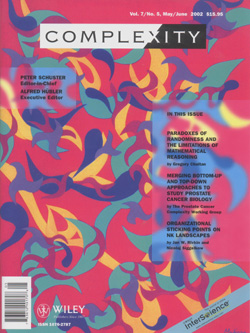

|
In Complexity 20, Jim Modiano has developed a system of abstract shapes which have the capacity to self-organize into a cohesive composition. In his process, these cut-out shapes are literally tossed onto a substrate allowing them to fall where they may. After all the shapes are tossed the outcome is observed, the shapes 'reshuffled' and tossed again. A single composition like the one seen here is actually a single outcome from among perhaps 50 trials. What
one sees through the course of repeated trials is that the type
organization the shapes assume tends toward three specific states:
there is an ordered state where the cut-outs are evenly spaced
with very little interaction; a chaotic state where the cut-outs
are all piled one on top the other in an incomprehensible mess;
and a complex state, as pictured here, where the cut-outs form
intricate arrays and the extent of their interactions is maximized. |
 |
Modiano believes that the abstract shapes he works with do constitute a system and that their behavior can be described as complex. His system of shapes is comprised of simple agents [individual cut-outs] that display the properties of self-organization [in the formation of the overall composition] and emergence [in the formation of meta-shapes resulting from the combinations of individual shapes]. While the compositions that result are driven by chance and randomness, Modiano recognizes that his shape systems are not true complex adaptive systems in that they are highly tuned visually: the choice of colors and color relationships, scaling, and the overt forms of the shapes themselves all remain under the control of the artist. Complexity Journal is Published by Wiley-Liss, Inc., A Wiley Company
|
|
© copyright 2023, Jim Modiano